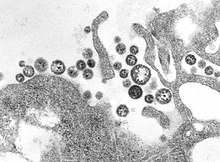Lassa mammarenavirus
| Lassa mammarenavirus | |
|---|---|

| |
virions
| |
| Virus classification | |
| (unranked): | Virus |
| Realm: | Riboviria |
| Kingdom: | Orthornavirae |
| Phylum: | Negarnaviricota
|
| Class: | Ellioviricetes |
| Order: | Bunyavirales |
| Family: | Arenaviridae |
| Genus: | Mammarenavirus |
| Species: | Lassa mammarenavirus
|
| Synonyms | |
| |
Lassa mammarenavirus (LASV) is an
As of 2012 discoveries within the
Discovery
In 1969, missionary nurse Laura Wine fell ill with a mysterious disease she contracted from an obstetrical patient in Lassa, a village in
Virology
Structure and genome

Lassa viruses[14][15] are enveloped, single-stranded, bisegmented, ambisense RNA viruses. Their genome[16] is contained in two RNA segments that code for two proteins each, one in each sense, for a total of four viral proteins.[17] The large segment encodes a small zinc finger protein (Z) that regulates transcription and replication,[18][19] and the RNA polymerase (L). The small segment encodes the nucleoprotein (NP) and the surface glycoprotein precursor (GP, also known as the viral spike), which is proteolytically cleaved into the envelope glycoproteins GP1 and GP2 that bind to the alpha-dystroglycan receptor and mediate host cell entry.[20]
Lassa fever causes hemorrhagic fever frequently shown by immunosuppression. Lassa mammarenavirus replicates very rapidly, and demonstrates temporal control in replication.[21] The first replication step is transcription of mRNA copies of the negative- or minus-sense genome. This ensures an adequate supply of viral proteins for subsequent steps of replication, as the NP and L proteins are translated from the mRNA. The positive- or plus-sense genome, then makes viral complementary RNA (vcRNA) copies of itself. The RNA copies are a template for producing negative-sense progeny, but mRNA is also synthesized from it. The mRNA synthesized from vcRNA are translated to make the GP and Z proteins. This temporal control allows the spike proteins to be produced last, and therefore, delay recognition by the host immune system.[citation needed]
Nucleotide studies of the genome have shown that Lassa has four lineages: three found in Nigeria and the fourth in Guinea, Liberia, and Sierra Leone. The Nigerian strains seem likely to have been ancestral to the others but additional work is required to confirm this.[22]
Receptors

Lassa mammarenavirus gains entry into the host cell by means of the cell-surface receptor the
Unlike most enveloped viruses which use clathrin coated pits for cellular entry and bind to their receptors in a pH dependent fashion, Lassa and lymphocytic choriomeningitis virus instead use an endocytotic pathway independent of clathrin, caveolin, dynamin and actin. Once within the cell the viruses are rapidly delivered to endosomes via vesicular trafficking albeit one that is largely independent of the small GTPases Rab5 and Rab7. On contact with the endosome pH-dependent membrane fusion occurs mediated by the envelope glycoprotein, which at the lower pH of the endosome binds the lysosome protein LAMP1 which results in membrane fusion and escape from the endosome.[citation needed]
Life cycle

The life cycle of Lassa mammarenavirus is similar to the Old World arenaviruses. Lassa mammarenavirus enters the cell by the
Pathogenesis
Lassa fever is caused by the Lassa mammarenavirus. The symptoms include flu-like illness characterized by fever, general weakness, cough, sore throat, headache, and gastrointestinal manifestations. Hemorrhagic manifestations include vascular permeability.[4]
Upon entry, the Lassa mammarenavirus infects almost every tissue in the human body. It starts with the
The main targets of the virus are antigen-presenting cells, mainly dendritic cells and endothelial cells.[26][27][28] In 2012 it was reported how Lassa mammarenavirus nucleoprotein (NP) sabotages the host's
See also
References
- ^ PMID 4246571.
- ^ "Lassa fever". www.who.int.
- S2CID 27063493.
- ^ PMID 23202452.
- ^ ISBN 978-0-312-37700-7.
- ^ "Lassa Fever | CDC". www.cdc.gov. Retrieved 2016-09-23.
- PMID 1614671.
- ^ OCLC 775277696.
- S2CID 4211129.
- S2CID 5188080.
- PMID 4429182.
- PMID 4429183.
- ^ PMID 23202512.
- ^ Jamie Dyal and Ben Fohner Lassa virus Stanford University Humans and Viruses Class of 2005, n.d. accessed 9 May 2018
- ^ Lashley, Felissa R., and Jerry D. Durham. Emerging Infectious Diseases: Trends and Issues. New York: Springer Pub., 2002. Print.
- ^ Ridley, Matt. Genome: The Autobiography of a Species in 23 Chapters. New York: HarperCollins, 1999. Print.
- ^ "Lassa virus RefSeq Genome".
- PMID 11533204.
- PMID 9281522.
- ^ PMID 9851928.
- ^ Lashley F (2002). Emerging Infectious Diseases Trends and Issues. Springer Publishing Company.
- PMID 10888638.
- ^ "Endemic: MedlinePlus Medical Encyclopedia".
- ^ PMID 18182084.
- ^ PMID 12615304.
- S2CID 38807245.
- PMID 12626527.
- PMID 14978087.
- PMID 22937163.
- PMID 22482712.
